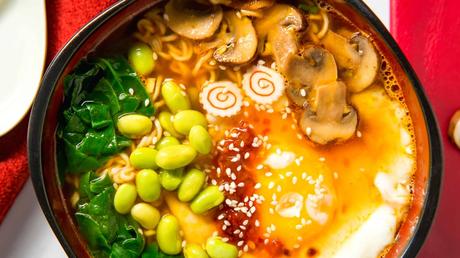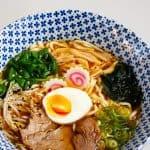When you eat at a ramen restaurant, you might come across some interesting (though odd) toppings on your noodles.
You are probably going to encounter the world-famous Narutomaki, also known as surimi fish cakes.
Then, you’ll wonder, ‘what is that white and pink swirly thing in my ramen bowl?’

It’s hard to imagine the taste, texture, and appeal of this food until you try it.
But once you do, you’ll understand why it’s the perfect savory topping for ramen.
This post discusses Kamaboko (Japanese fish cakes) and specifically Narutomaki, a common variation used as a topping on ramen noodle soup and soba noodles.
Kamaboko Fish Cakes: What are they?
The word Kamaboko means fish cakes.
The fish cakes are made out of cured surimi, which is ground, deboned, and pureed white fish meat.
This processed seafood product is a popular Japanese side dish or garnish.
In Japanese cuisine, fish cakes are added to ramen, soba noodles, salads, and soups. Each fish cake type is tailored to match whatever dish it’s used for (usually ramen or soba noodles).
There’s a wide variety of fish cakes in different shapes, colors, and flavors.
But what they all have in common is the mild umami (savory) fishy taste and the unique appearance.
The fish paste is also cooked in different ways. Depending on the dish, it is steamed, boiled, grilled, and even fried.
Kamaboko is a versatile dish because it has a particularly strong fish flavor, adding a lot of umami taste to any dish.
The fish cake has an outer light pink layer and is sliced into small semi-circular pieces. It’s quite a chewy food, but it has a soft texture.
Narutomaki is the most popular type of fish cake because it’s so common in ramen.
We’ll soon get into the details of this delicate dish and share a tasty ramen and fish cake recipe you can try at home.
What are fish cakes made of?
The surimi fish paste is made out of deboned white fish.
Usually, Japanese chefs make Kamaboko and Narutomaki from the following fish:
- Alaska Pollock
- Silver White Croaker
- Splendid Alfonsino
- Southern Blue Whiting
First, the fish is deboned, pureed, and mixed with egg whites and salt.
Then, the resulting surimi is molded into the desired shape and steamed so that it keeps its form.
Depending on the type of fish cake, it may be fried or grilled instead of steamed.
But, the steaming process helps it maintain the log form required for Narutomaki.
The fish cake is not added to the food while it cooks. Instead, you add it to a dish at the end as a garnish.
Narutomaki: What is it?
Narutomaki, or Naruto, is a popular type of Kamaboko, mostly used as the fish cake topping in ramen dishes.
It looks like a slice of white and pink swirly flat cake, and it’s usually placed on top of the noodles as a topping or garnish.
It’s cut into a long cross-section or a circular shape.
This particular fish cake is also made out of pureed white fish (surimi) and has a mild, subtle flavor. It is slightly less chewy than Kamaboko.
The surimi mix contains starch, which acts as a binding agent and makes the texture doughy.
The starch also makes it powdery and similar in texture to pasta. Thus it matches the texture of the noodles.
The pink swirl has a wavelike pattern, which resembles the Naruto whirlpools, located between Shikoku and Awaji Island.
According to legend, the whirlpools are the inspiration behind the famous fish cakes.
The best Narutomaki is manufactured in the Yaizu, Shizuoka region of Japan. In fact, Yaizu produces more than 90% of all Naruto.
However, not all fish cakes are created equal, and some brands taste better than others.
Variations of Japanese Fishcakes
Did you know that there are two types of Naruto?
The most common variety you see is the classic white exterior with a pink swirl interior. The Japanese consider this to be the ‘regular’ and ‘traditional’ Narutomaki.
Aka Naruto Maki refers to the inverted color version of this dish.
The exterior or base layer is all pink colored, and the inside swirl is white. This variety is less common and almost exclusive to three Japanese regions: Hokkaido, Tohoku, and Kyushu.
Some experimental chefs like to play around with the colors. You may see a white exterior with a green swirl inside.
Some even replace the swirl with symbols and other patterns.
For example, the Sho Chiku Bai is a plum, pine, and bamboo pattern representing the Japanese icon of happiness.
How to make Narutomaki
The Naruto recipe is similar to most other fish cakes, but it has a log shape and a pink swirly center with textured edges.
- To get started, combine the fish paste with egg whites and starch.
- Then, take the mixture and split it into two equal parts.
- Next, take the first part of the mix and flatten it out on a bamboo mat into a longer rectangle shape.
- Then, take the second part of the paste and color it using a few red food coloring drops. The paste needs to have a light red or pink color.
- To assemble it, take the pink paste and spread it on top of the white base. Make sure the bottom layer’s edges are left uncovered. This creates the ridged edges.
- To make the log shape, roll it together.
- Once it takes a log shape, steam the Naruto.
- Slice it into thin pieces long cross sections and garnish your ramen.
 Print
Print
Spicy Shoyu Ramen Recipe with Naruto
Shoyu is one of the most traditional and common types of ramen. Shoyu means ‘soy sauce’ in Japanese, so this soup has a savory (umami) flavor and a brownish color. The spicy chili bean broth is sure to please since the noodles melt in your mouth. The combination of chicken broth with the Chashu Pork is delicious. Naruto enhances the flavors with that salty, fishy taste. It’s definitely a wholesome dish that you can eat at any time of day. Course SoupCuisine Japanese Servings 1Ingredients
Ingredients for one bowl
- 150-200 grams ramen noodles
- 350 ml chicken broth
- 1 tbsp sesame oil
- 1 tsp kosher salt
- ½ tsp sake
- 1 tsp sugar
- 3 tsp soy sauce
- 2 garlic cloves
- 1 inch piece of ginger minced
- 2 tbsp spicy chili bean paste Doubanjiang
- 2 cups dashi
Toppings
- 1 slice cooked Chashu Japanese pork belly
- 1 boiled egg
- ½ green onion
- 4 / 5 slices Narutomaki
- ½ sheet of Nori seaweed paper
Instructions
- Grab a large pot and heat the sesame oil on medium heat.
- Add the garlic and ginger and saute until it releases fragrance.
- Mix in the spicy chili bean paste and stir.
- Now add in the chicken broth, dashi, soy sauce, salt, sake, and sugar. Bring it all to a boil, then let it simmer for several minutes.
- Let the soup simmer until you prepare the other ingredients.
- In a large bowl, boil water and cook your ramen noodles. Make sure not to overcook them, as they will continue to cook in the chicken broth.
- Grab a serving bowl and place your ramen noodles at the base. Pour soup over it and add the toppings. Add the Naruto in last to add a nice decorative touch.
History of Narutomaki
You might be wondering why the Naruto is such a common ramen topping?
It has a long tradition in Japanese cuisine, but its primary role is not to enhance flavor but to add visual contrast to the soup’s brownish colors.
The Naruto has a ridged exterior edge and a pretty pink center; thus, it enhances any dish’s presentation.
Initially, Japanese chefs used Naruto as a topping for Soba noodles in the Edo period (about 150 years ago).
At the time, ramen wasn’t even invented yet. Ramen was popularized sometime in the early 1900s when it was brought over from China.
Since Narutomaki was a popular topping for soba, people quickly adapted it for ramen since it was also a noodle dish.
Is Japanese fish cake healthy?
As with any fish dish, the health and nutritional benefits depend upon the fish’s quality and the preparation methods.
In general, a well-made Kamaboko is full of health benefits. It is low in fat, full of good nutrients, and has lots of protein.
Also, this dish is low in calories, so it’s not a source of dangerous fats. It also has antioxidant properties, helping the body neutralize free radicals.
However, there is one disadvantage.
Most of the cheaper store-bought Kamaboko and Narutomaki is high in sodium and contains MSG.
If you want healthy options, look for higher-priced fish cakes that are produced using high-quality white fish.
Also, check the list of ingredients and avoid anything with too many additives and preservatives.
So, you’re wondering where to find Kamaboko and Narutomaki?
The best place to buy it from is Asian grocery stores or eat it at ramen restaurants.
Can you make Narutomaki at home?
It is uncommon for Japanese people to make Narutomaki at home because it’s an elaborate dish.
Making it requires many many steps and specialty tools.
The ingredients are often hard to procure, and it’s a time-consuming cooking process.
Therefore, most people buy this dish at the supermarket or eat it while dining at a ramen restaurant.
Now, if you’re feeling hungry and curious, you can go check out a local Asian grocery shop, as you might find Kamaboko and Narutomaki there.
If not, Asian restaurants are sure to serve it alongside tasty noodle dishes. What I can tell you for sure is that it’s one of the most unique fishy toppings you’ll come across!
Next, read all about Japanese Udon noodles: how to use these thick noodles.
